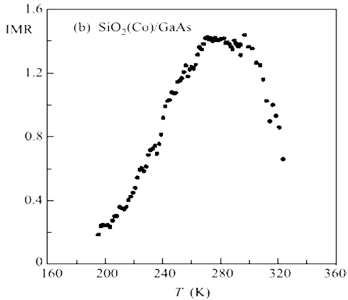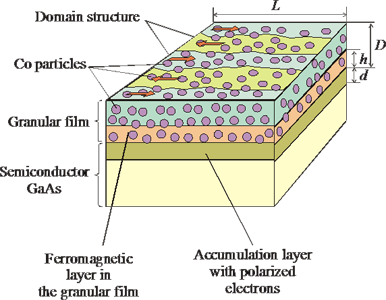| Направления / Магнетизм и сильнокоррелированные системы / Спинтроника |
| |
Спинтроника |
|
| |
Neutron reflectivity study of composite heterosructures GaAs / granular film SiO2 with Co nanoparticles |
|
| |
Sergey Grigoriev, Yury Chetverikov, PNPI, Gatchina, St-Petersburg, Russia
Natalia Grigoryeva, SPSU, St-Petersburg, Russia
Dieter Lott, GKSS Forschungszentrum |
|
| |
Objectives |
|
| |
The interest in ferromagnet/semiconductor (FM/SC) interfaces is increasing due to the possibility of employing these structures as spin injectors of polarized electrons in SCs [1–3]. Transfer of spin-polarized electrons (spin injection) from a magnetic contact into a nonmagnetic SC is intended for use in spintronic devices such as spin transistors, sensors and magnetic memory cells [4, 5]. It is noticed that the spin injection depends on a potential barrier formed at the interface. Although significant progress has been made, the efficient spin injection has not been achieved and the highly efficient spin injection into SCs at room temperature is the actual problem. This problem can be resolved by using FM/SC heterostructures with an accumulation electron layer in the SC at the interface. The exchange interaction between d (f) electrons in the FM at the interface and electrons in the SC polarizes electrons in the accumulation layer. This interaction forms a potential barrier for spin-polarized electrons injected from the FM. |
|
| |
|
|
|
|
| |
Recently a new phenomenon was observed [6]: the giant injection magnetoresistance in Gallium-Arsenide/Granulated-Film heterostructures with nanosize cobalt inclusions. The room temperature magnetoresistance values appeared to be two orders of magnetude higher than maximum values of magnetoresistance achieved up to now in magnetic tunnel junction structures and metal multilayers. The magnetoresistance effect is observed in the temperature range [200 - 350 K] and depends on an applied magnetic field. It is suggested that the magnetoresistance effect is due to the ferromagnetic layer in the granular film SiO2 (Co) and due to the accumulation layer with polarized electrons formed in the semiconductor near the interface. In our investigation we study this composite heterosructures using polarized neutron reflectometry. |
|
| |
Samples |
|
| |
Composite heterosructure GaAs / granular film SiO2 with Co nanoparticles was prepared by the magnetron sputtering. The average size of the ferromagnetic Co particles was determined from the small-angle X-ray scattering measurements: 2.5 - 5 nm. The thickness D of the granular film SiO2 (Co) is equal to 47 nm and the thickness of the GaAs is 0.4 mm. |
|
| |
Experimental Technique |
|
| |
The experiments were carried out at the NeRo reflectometer of FRG-1 research reactor in Geesthacht (Germany). A polarized beam of neutrons with an initial polarization of P0=0.95, the neutron wavelength l=4.35 Å (Dl/l=0.02) was used. The scattered neutrons were detected by a position sensitive detector (PSD) with (256x256) pixels. The sample was set in a standard position to measure the reflectivity from the granular film of SiO2 with Co on the GaAs substrate. The polarization followed the direction of the magnetic field (from 1 to 900 mT), which was applied perpendicularly to the incident beam and parallel to film surface. The reflected intensity was measured in the temperature range from T=100 to T=450 K for two incident polarizations I(±P0) along and opposite of the guiding magnetic field. |
|
| |
Results |
|
| |
Typical reflectivity profiles from the sample taken with the polarized neutron beam at T = 120 K are shown in Fig. 2 for the applied magnetic field H = 14 and 346 mT. |
|
| |
|
|
| |
The data were taken after remagnetization process i.e. after application of the opposite magnetic field of 900 mT. It is well seen that, firstly, the granular film SiO2 (Co) is magnetized what results in splitting of the profiles with polarization up (+) and polarization down (-). Secondly, the splittings (in a small and large magnetic fields) have the opposite signs indicating the presence of the hysteresis in the magnetization. The splitting DI = I(+P0) – I (-P0) was measured at the angle 2q = 0.3 degree as a function of the magnetic field at different temperatures (Fig.3). |
|
| |
|
|
| |
The hysteresis curves obtained are characterized by the coercive force HC and by the saturation value of the splitting at large fields DISAT, which is an analogue of the saturation magnetization. Both value HC and DISAT decreases with an increase of temperature. The temperature dependence of HC is shown in Fig.4. |
|
| |
|
|
| |
The room temperature magnetoresistance values appeared to be two orders of magnetude higher than maximum values of magnetoresistance achieved up to now in magnetic tunnel junction structures and metal multilayers. The magnetoresistance effect is observed in the temperature range [200 K - 350 K] and depends on an applied magnetic field. It is suggested that the magnetoresistance effect is due to the ferromagnetic layer in the granular film SiO2 (Co) and due to the accumulation layer with polarized electrons formed in the semiconductor near the interface. |
|
| |
|
|
| |
Spins of Co nanoparticles in the ferromagnetic layer are polarized by the RKKY-like interaction through electrons of accumulation layer. According to our estimation the thickness h of the ferromagnetic layer in the granular film is 5 - 8 nm,the thickness d of the accumulation layer with polarized electrons is equal to 10 - 20 nm (synchrotron data). |
|
| |
References |
|
| |
[1] I. Zutic, J. Fabian and S. Das Sarma Rev. Mod. Phys. 76 (2004) 323.
[2] B. P. Zakharchenya and V. L. Korenev, Phys. Usp. 175 (2005) 603.
[3] R. Bertacco, M. Riva, M. Cantoni,F. Ciccacci, M. Portalupi, A. Brambilla, L. Duo, P. Vavassori, F. Gustavsson, J.-M.George, M. Marangolo, M. Eddrief and V.H. Etgens, Phys. Rev. B 69 (2004) 054421.
[4] S. A. Wolf, D.D. Awschalom, R.A. Buhrman, J.M. Daughton, S. von Molnar, M.L. Roukes, A.Y. Chtchelkanova and D.M. Treger, Science 294 (2001) 1488.
[5] G. Schmidt, J. Phys. D: Appl. Phys. 38 (2005) R107.
[6] L. V. Lutsev, A. I. Stognij, and N. N. Novitskii, JETP Letters 81(10) (2005) 514. |
|
| |
|
|





